Uncategorized
Crypto Daybook Americas: XRP, AI Coins Eye Big Moves While Bitcoin in Stasis Ahead of CPI

By Omkar Godbole (All times ET unless indicated otherwise)
The market is about to be hit with the first big U.S. economic event of 2025: December CPI data.
With hawkish Fed fears in the air and bitcoin strengthening its correlation with tech stocks, Wednesday’s report becomes even more significant for the digital assets market. The stalled liquidity inflows through stablecoins have also raised question marks on the sustainability of price recovery from under $90K, and traders are preparing for potential downside volatility by adding short-dated puts.
Here’s what experts are saying about the upcoming event:
QCP Capital
«In crypto, cautious sentiment is evident in BTC options flows, with puts rolled below the key $90k support. Front-end vols and flies remain elevated, while the VIX stays high at 18.68 – suggesting volatility to persist through January.»
Geoffrey Chen, author of the Fidenza Macro blog
«The rising markets in November and the lifting of election uncertainty pushed business confidence higher, resulting in stronger data. The frontloading of goods imports and the raising of prices to get ahead of tariffs may have also contributed to higher PMIs. On top of that, oil has woken up and rallied over 10% from its December levels, reinforcing the stagflation regime. None of this bodes well for CPI tomorrow [Jan. 15] and the FOMC later this month. These risk events may surprise towards hawkish and stagflationary outcomes, putting more pressure on risk assets.”
Markus Thielen, founder of 10x Research
«Bitcoin continues to trade within a narrowing wedge, with several critical catalysts on the horizon. Expectations for a higher CPI number have risen, creating a scenario where a softer-than-expected inflation reading could trigger a bitcoin rally.»
Focus on XRP and AI
XRP surged to $2.90 early today, matching the December high with technical analysis suggesting a continued run higher. Meanwhile, according to Wintermute, dip buyers have been active in AI coins, namely FAI, GRASS, VIRTUAL, Ai16z and TAO.
These coins, therefore, could chalk out bigger gains in case the CPI spurs renewed risk-taking in financial markets.
What to Watch
Crypto
Jan. 15: Degen liquidity mining airdrop; the last snapshot was taken at the end of Jan. 14 (UTC).
Jan. 15: Mintlayer version 1.0.0 release. The mainnet upgrade introduces atomic swaps, enabling native BTC cross-chain swaps.
Jan. 17: Oral arguments at the U.S. Court of Appeals for the District of Columbia Circuit in KalshiEX LLC v. CFTC, where the CFTC is appealing the district court’s Sep. 12, 2024 ruling favoring Kalshi’s Congressional Control Contracts.
Jan. 23: First deadline for a decision by the U.S. SEC on the proposal filed on Dec. 3, 2024 by NYSE Arca to list and trade shares of Grayscale Solana Trust (GSOL), a closed-end trust, as an ETF.
Jan. 25: First deadline for decisions by the U.S. SEC on the proposals for four new spot solana (SOL) ETFs: Bitwise Solana ETF, Canary Solana ETF, 21Shares Core Solana ETF, and VanEck Solana Trust, which are all sponsored by Cboe BZX Exchange.
Macro
Jan. 15, 2:00 a.m.: The U.K.’s Office for National Statistics released December 2024’s inflation data.
Core Inflation Rate MoM Act. 0.3% vs. Prev. 0%.
Inflation Rate MoM Act. 0.3% vs. 0.1%.
Core Inflation Rate YoY Act. 3.2% vs. Prev. 3.5%.
Inflation Rate YoY Act. 2.5% vs. Prev. 2.6%.
Jan. 15, 8:30 a.m.: The U.S. Bureau of Labor Statistics (BLS) releases December 2024’s Consumer Price Index Summary.
Core Inflation Rate MoM Est. 0.2% vs. Prev. 0.3%.
Core Inflation Rate YoY Est. 3.3% vs. Prev. 3.3%.
Inflation Rate MoM Est. 0.3% vs. Prev. 0.3%.
Inflation Rate YoY Est. 2.8% vs. Prev. 2.7%.
Jan. 16, 2:00 a.m.: The U.K.’s Office for National Statistics November 2024’s GDP estimate.
GDP MoM Est. 0.2% vs. Prev. -0.1%.
GDP YoY Prev. 1.3%.
Jan. 16, 8:30 a.m.: The U.S. Department of Labor releases the Unemployment Insurance Weekly Claims Report for the week ending on Jan. 11. Initial Jobless Claims Est. 214K vs. Prev. 201K.
Jan. 17, 5:00 a.m.: Eurostat releases December 2024’s Eurozone inflation data.
Inflation Rate MoM Final Est. 0.4% vs Prev. -0.3%.
Core Inflation Rate YoY Final Est. 2.7% vs. Prev. 2.7%.
Inflation Rate YoY Final Est. 2.4% vs. Prev. 2.2%.
Token Events
Governance votes & calls
Compound DAO is discussing strategies to grow its treasury. The proposal seeks $9.5M of ETH and $5M of COMP, which would be used to generate a yield and boost its USDC holdings.
Balancer DAO is discussing deploying the v3 version of its platform on layer-2 network Base. If approved, Balancer expects deployment by the end of January.
Unlocks
Jan. 15: Connex (CONX) to unlock 376% of its circulating supply, worth $84.5 million.
Jan. 16: Arbitrum (ARB) to unlock 2.2% of its circulating supply, worth $68 million.
Jan. 18: Ondo (ONDO) to unlock 134% of its circulating supply, worth $2.19 billion.
Token Launches
Jan. 15: Derive (DRV) will launch, with 5% of supply going to sENA stakers.
Jan. 16: Solayer (LAYER) to host token sale followed by five months of points farming.
Jan. 17: Solv Protocol (SOLV) to be listed on Binance.
Conferences:
Day 10 of 14: Starknet, an Ethereum layer 2, is holding its Winter Hackathon (online).
Day 3 of 12: Swiss WEB3FEST Winter Edition 2025 (Zug, Zurich, St. Moritz, Davos)
Jan. 17: Unchained: Blockchain Business Forum 2025 (Los Angeles)
Jan. 18: BitcoinDay (Naples, Florida)
Jan. 20-24: World Economic Forum Annual Meeting (Davos-Klosters, Switzerland)
Jan. 21: Frankfurt Tokenization Conference 2025
Jan. 25-26: Catstanbul 2025 (Istanbul). The first community conference for Jupiter, a decentralized exchange (DEX) aggregator built on Solana.
Jan 30-31: Plan B Forum (San Salvador, El Salvador)
Feb. 3: Digital Assets Forum (London)
Feb. 18-20: Consensus Hong Kong
Token Talk
By Oliver Knight
Toshi, a memecoin on layer-2 network Base, has risen by more than 70% in the past 24-hours after it was added to Coinbase’s future listing roadmap. TOSHI’s market cap has now topped $100 million.
Non-fungible token (NFT) trading volume fell by 19% in 2024 compared to the previous year, making it the worst performing year since 2020, a DappRadar report shows.
The Ondo community are bracing for mammoth $2.2 billion token unlock this week as circulating supply is set to jump by 134%. The majority of supply has been allocated to «ecosystem growth,» however $377 million will be distributed to participants of a private sale. Unlocks of this magnitude typically heap pressure on the underlying asset, although a significant increase in short positions could spur a short squeeze, a trend that has been seen since 2023.
Binance Alpha has posted a new batch of projects that are being considered for listing on the exchange. These include VITA, GRIFT, VITA Aimonica, the latter two are AI agent tokens.
Derivatives Positioning
XLM has seen a 27% surge in perpetual futures open interest, the highest among major tokens, with cumulative volume delta pointing to net buying pressure. The combination supports an extension of the past 24 hours’ 11% price rise.
Large positive dealer gamma is seen at $97K, according to Deribit’s options market. Positive gamma means market makers will likely trade against the market direction, arresting price volatility.
In ETH’s case, a large negative gamma is seen closer to its going market rate, suggesting potential for increased price turbulence.
Front-dated risk reversals continue to show bias for BTC, ETH puts.
Notable block flows include a long BTC straddle, involving $97K options expiring on Jan. 24. The strategy profits from a volatility explosion.
Market Movements:
BTC is up 0.51% from 4 p.m. ET Tuesday to $96,951.13 (24hrs: +0.4%)
ETH is down 0.24% to $3,207.75 (24hrs: -0.37%)
CoinDesk 20 is up 1.88% to 3,546.65 (24hrs: +2.35%)
Ether staking yield is unchanged at 3.12%
BTC funding rate is at 0.0059% (6.49% annualized) on Binance
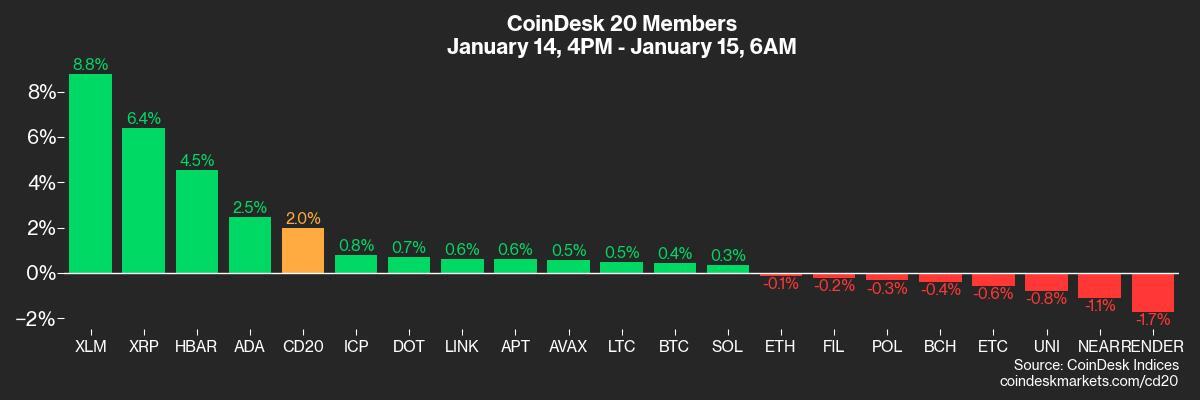
DXY is down 0.23% to 109.02
Gold is up 1.28% to $2,646.45/oz
Silver is up 2.16% to $30.78/oz
Nikkei 225 closed on Tuesday unchanged at 38,444.58
Hang Seng closed +0.34% at 19,286.07
FTSE is up 0.74% to 8,262.35
Euro Stoxx 50 is up 0.34% at 4,997.65
DJIA closed +0.52% at 42,518.28
S&P 500 closed +0.11% at 5,842.91
Nasdaq closed -0.23% at 19,044.39
S&P/TSX Composite Index closed +0.21% at 24,588.60
S&P 40 Latin America closed +0.69% at 2,207.79
U.S. 10-year Treasury is down 2 bps to 4.77%
E-mini S&P 500 futures are up 0.16% to 5,891.50
E-mini Nasdaq-100 futures are up 0.22% to 20,965.25
E-mini Dow Jones Industrial Average Index futures are up 0.2% at 42,836.00
Bitcoin Stats:
BTC Dominance: 58.21
Ethereum to bitcoin ratio: 0.033
Hashrate (seven-day moving average): 790 EH/s
Hashprice (spot): $55.2
Total Fees: 6.54 BTC/
CME Futures Open Interest: 177,355 BTC
BTC priced in gold: 36.1 oz
BTC vs gold market cap: 10.26%
Technical Analysis
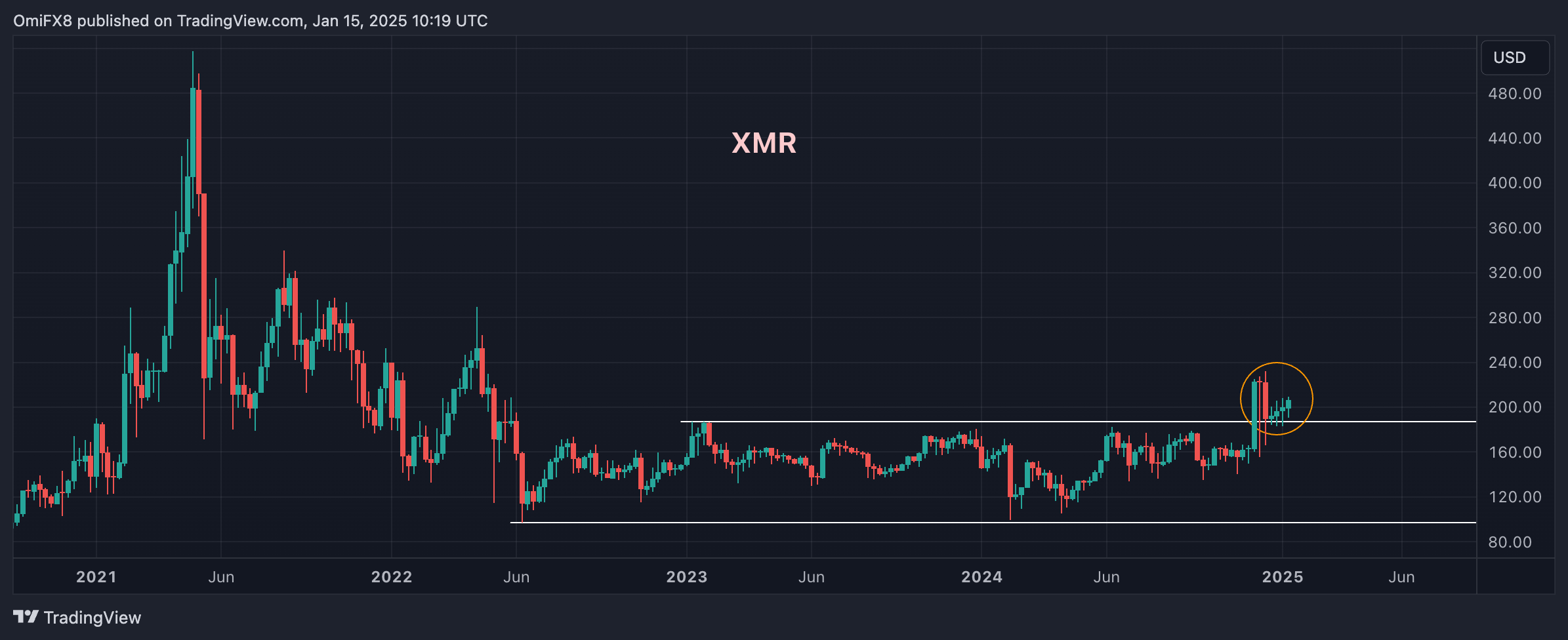
The above chart shows privacy-focused cryptocurrency’s weekly price changes in a candlestick pattern since late 2020.
XMR recently broke out of a prolonged consolidation/basing pattern and has validated the same with the bullish re-test of the breakout point.
Now, the market may unleash the energy built during consolidation, taking prices higher to resistance at $289, the April 2022 high.
Crypto Equities
MicroStrategy (MSTR): closed on Tuesday at $342.17 (+4.19%), down 0.51% at $340.44 in pre-market.
Coinbase Global (COIN): closed at $255.37 (+1.66%), down 0.17% at $254.93 in pre-market.
Galaxy Digital Holdings (GLXY): closed at C$26.6 (+2.15%)
MARA Holdings (MARA): closed at $17.36 (+0.99%), unchanged in pre-market.
Riot Platforms (RIOT): closed at $12.24 (+3.99%), down 0.25% at $12.21 in pre-market.
Core Scientific (CORZ): closed at $13.91 (+2.2%), up 1.51% at $14.12 in pre-market.
CleanSpark (CLSK): closed at $10.35 (+1.57%), down 0.39% at $10.31 in pre-market.
CoinShares Valkyrie Bitcoin Miners ETF (WGMI): closed at $23.07 (+3.83%).
Semler Scientific (SMLR): closed at $54.93 (+4.23%), up 0.31% at $55.10 in pre-market.
Exodus Movement (EXOD): closed at $33.07 (-1.52%), down 1.66% at $32.52 in pre-market.
ETF Flows
Spot BTC ETFs:
Daily net flow: -$209.8 million
Cumulative net flows: $35.71 billion
Total BTC holdings ~ 1.131 million.
Spot ETH ETFs
Daily net flow: -$39.4 million
Cumulative net flows: $2.41 billion
Total ETH holdings ~ 3.540 million.
Source: Farside Investors, as of Jan. 14
Overnight Flows
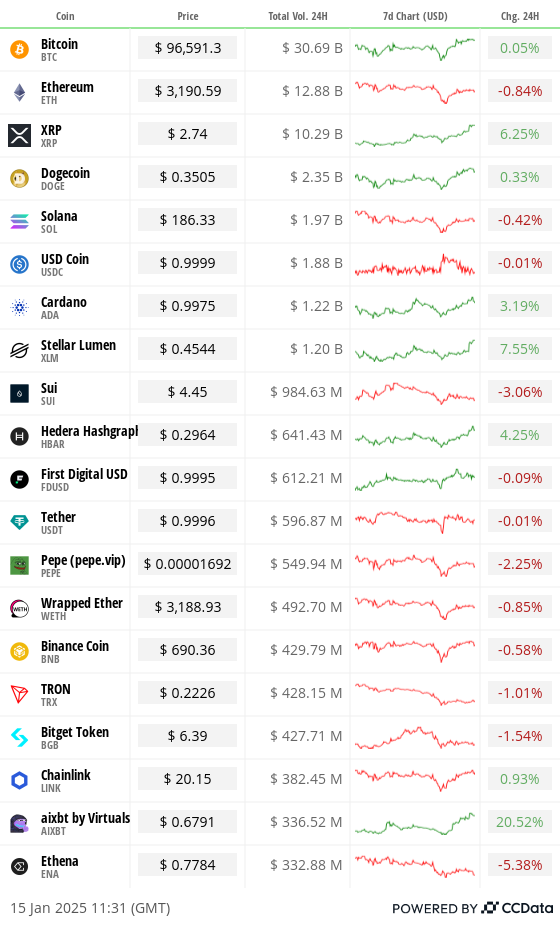
Chart of the Day
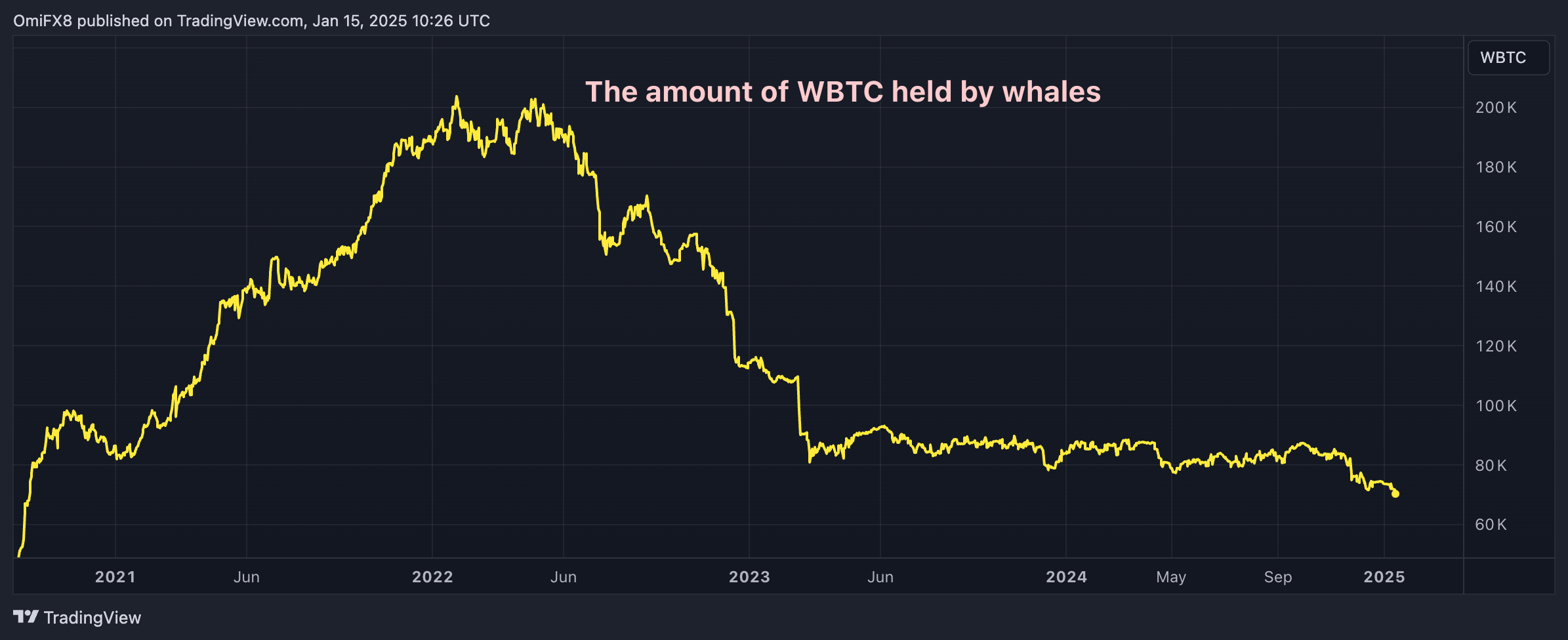
Cryptocurrency whales continue to run down their holdings of wrapped bitcoin (WBTC), an Ethereum token intended to represent bitcoin on the Ethereum-based DeFi applications.
The balance held by whales has dropped to 70.33K WBTC, the lowest in over four years.
While You Were Sleeping
Stalled Stablecoin Supply Casts Doubt on BTC’s Bullish Recovery As U.S. Inflation Report Looms (CoinDesk): Bitcoin’s recovery above $90,000 hints at bullish potential. However, declining stablecoin inflows signal weaker liquidity, increasing the likelihood of volatility following today’s U.S. retail inflation (CPI) data release.
Thailand Mulls Allowing First Bitcoin ETF in Bid to Boost Sector (Bloomberg): Thailand’s SEC is considering allowing Bitcoin ETFs to boost its digital-assets hub ambitions. Its secretary-general said the country must adapt to growing global cryptocurrency adoption while ensuring investor protections.
Crypto Hedge Funds Had a Great 2024, but Failed To Beat Bitcoin (Bloomberg): Crypto hedge funds gained 40% in 2024, according to the VisionTrack Composite Index, but trailed Bitcoin’s 120% surge to over $100,000. Investor sentiment was boosted by optimism around Trump’s pro-crypto stance.
U.K. Inflation Eases in Boost to Rate-Cut Chances (The Wall Street Journal): U.K. consumer inflation eased to 2.5% year-over-year in December, down from 2.6% in November. The slowdown boosts expectations for further BOE rate cuts, though inflation remains above the 2% target.
South Korean Investigators Arrest Impeached President Yoon in Insurrection Probe (Reuters): Impeached South Korean President Yoon Suk Yeol, the first sitting president arrested, was taken into custody Wednesday on insurrection charges. The Constitutional Court is deliberating whether to uphold his impeachment or reinstate him.
Emerging Market Stocks Slide on Trump Tariff Threats and Strong Dollar (Financial Times): The MSCI Emerging Markets Index, tracking $7.6 trillion in stocks, is down over 10% since Oct. 2, as fears of Trump’s inflationary policies, higher trade tariffs, and rising U.S. Treasury yields drive investor exits.
In the Ether

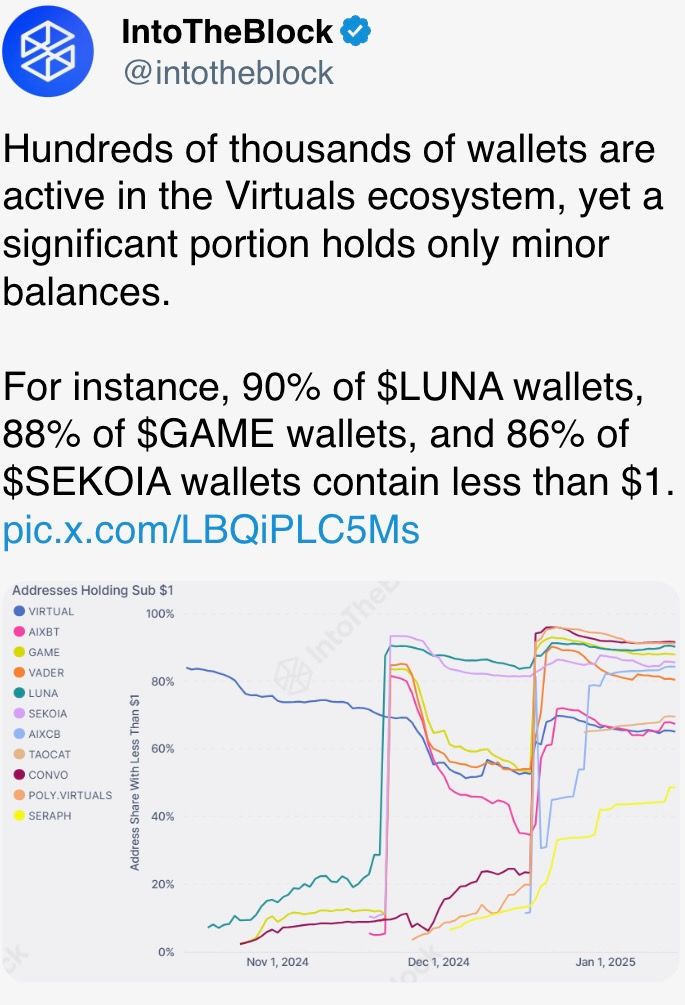
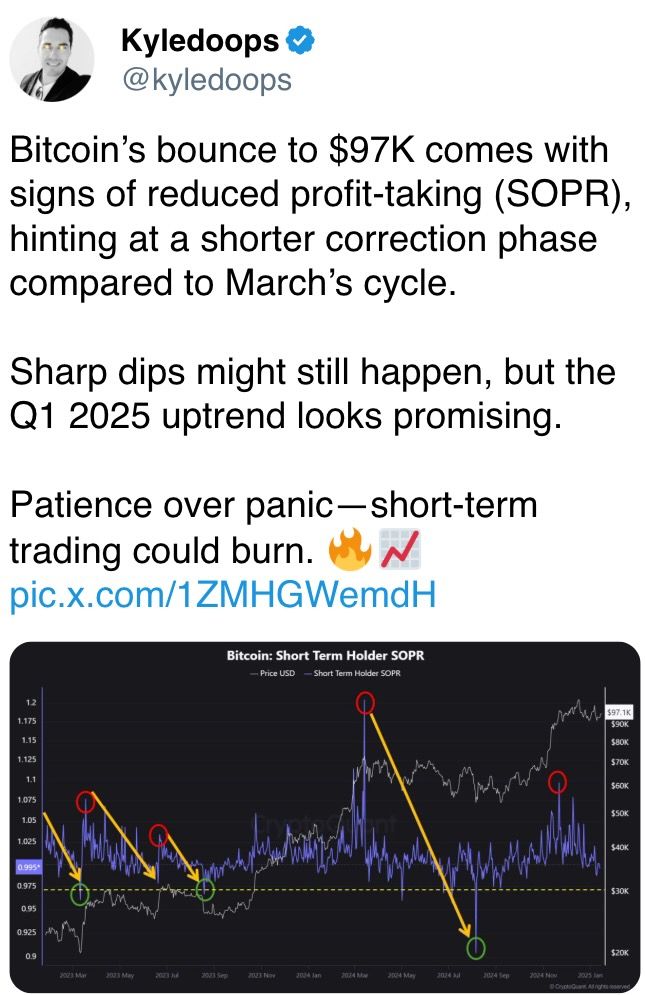
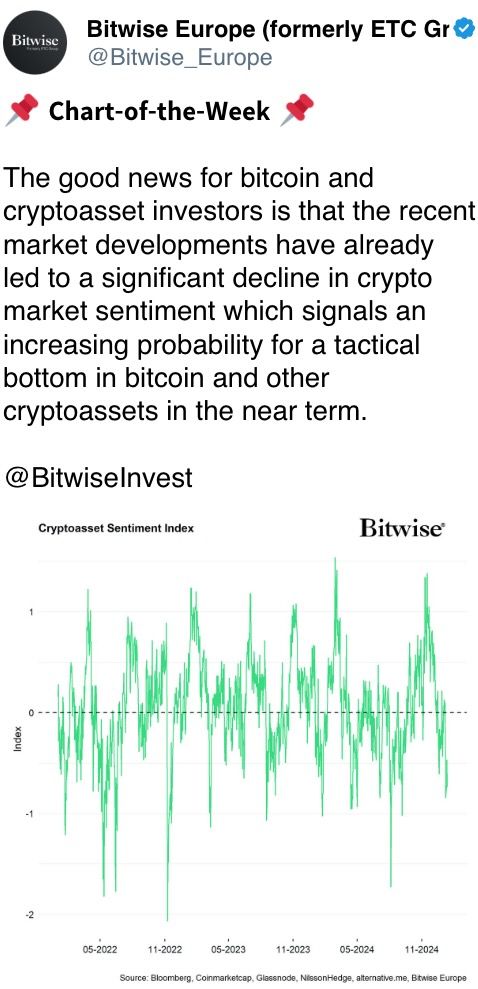
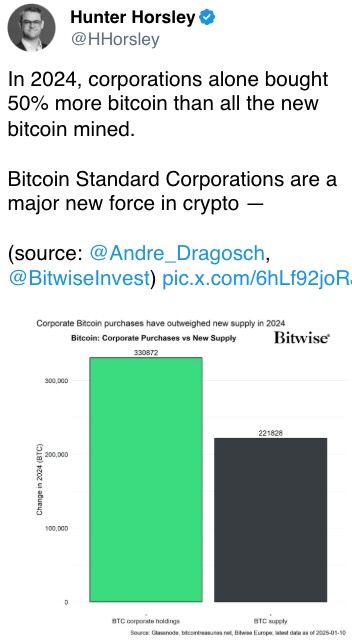
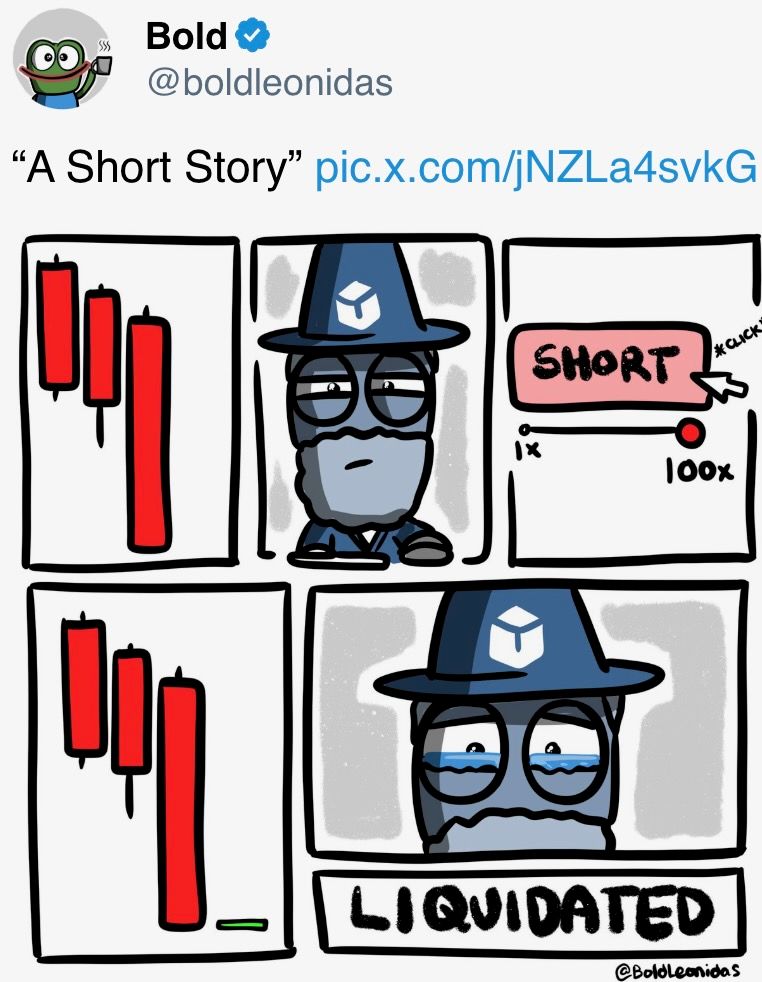
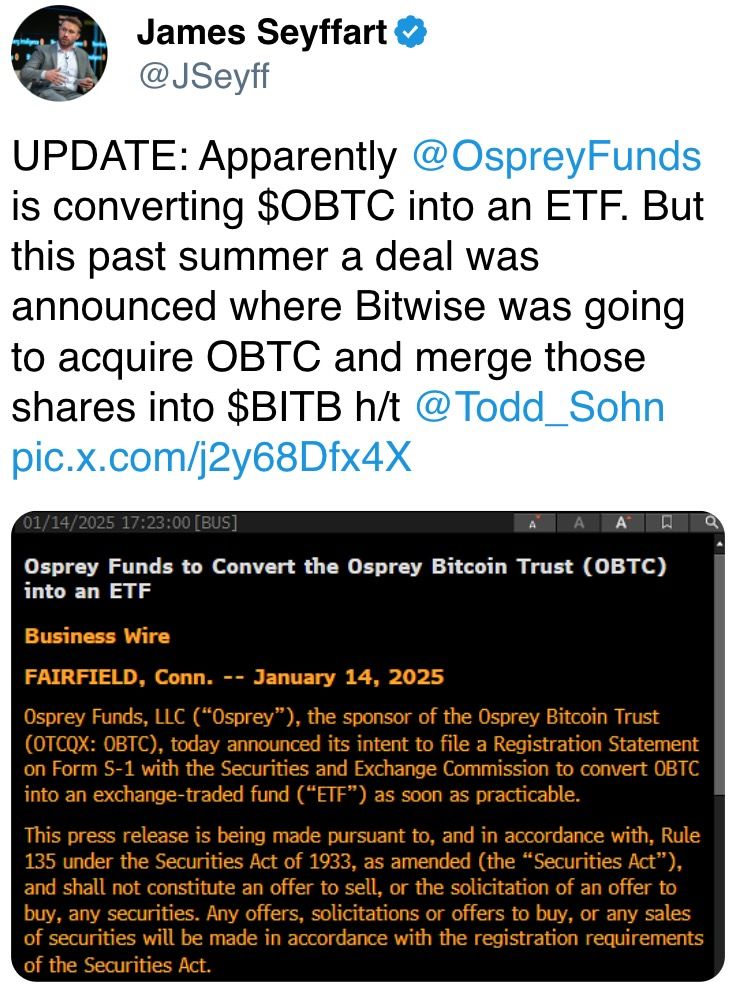
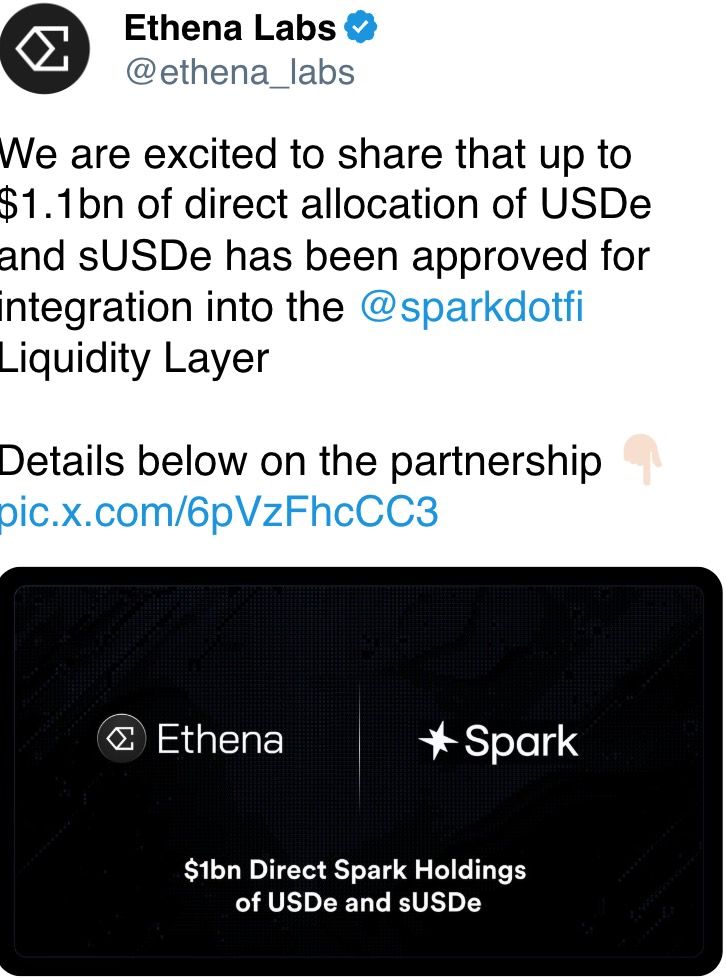
Business
AAVE Sees 64% Flash Crash as DeFi Protocol Endures ‘Largest Stress Test’

The native token of Aave (AAVE), the largest decentralized crypto lending protocol, was caught in the middle of Friday’s crypto flash crash while the protocol proved resilient in a historic liquidation cascade.
The token, trading at around $270 earlier in Friday, nosedived as much as 64% later in the session to touch $100, the lowest level in 14 months. It then staged a rapid rebound to near $240, still down 10% over the past 24 hours.
Stani Kulechov, founder of Aave, described Friday’s event as the «largest stress test» ever for the protocol and its $75 billion lending infrastructure.
The platform enables investors to lend and borrow digital assets without conventional intermediaries, using innovative mechanisms such as flash loans. Despite the extreme volatility, Aave’s performance underscores the evolving maturity and resilience of DeFi markets.
«The protocol operated flawlessly, automatically liquidating a record $180M worth of collateral in just one hour, without any human intervention,» Kulechov said in a Friday X post. «Once again, Aave has proven its resilience.»
Key price action:
- AAVE sustained a dramatic flash crash on Friday, declining 64% from $278.27 to $100.18 before recuperating to $240.09.
- The DeFi protocol demonstrated remarkable resilience with its native token’s 140% recovery from the intraday lows, underpinned by substantial trading volume of 570,838 units.
- Following the volatility, AAVE entered consolidation territory within a narrow $237.71-$242.80 range as markets digested the dramatic price action.
Technical Indicators Summary
- Price range of $179.12 representing 64% volatility during the 24-hour period.
- Volume surged to 570,838 units, substantially exceeding the 175,000 average.
- Near-term resistance identified at $242.80 capping rebound during consolidation phase.
Disclaimer: Parts of this article were generated with the assistance from AI tools and reviewed by our editorial team to ensure accuracy and adherence to our standards. For more information, see CoinDesk’s full AI Policy.
Business
Blockchain Will Drive the Agent-to-Agent AI Marketplace Boom

AI agents, software systems that use AI to pursue goals and complete tasks on behalf of users, are proliferating. Think of them as digital assistants that can make decisions and take actions towards goals you set without needing step-by-step instructions — from GPT-powered calendar managers to trading bots, the number of use cases is expanding rapidly. As their role expands across the economy, we have to build the right infrastructure that will allow these agents to communicate, collaborate and trade with one another in an open marketplace.
Big tech players like Google and AWS are building early marketplaces and commerce protocols, but that raises the question: will they aim to extract massive rents through walled gardens once more? Agents’ capabilities are clearly rising, almost daily, with the arrival of new models and architectures. What’s at risk is whether these agents will be truly autonomous.
Autonomous agents are valuable because they unlock a novel user experience: a shift from software as passive or reactive tools to active and even proactive partners. Instead of waiting for instructions, they can anticipate needs, adapt to changing conditions, and coordinate with other systems in real time, without the user’s constant input or presence. This autonomy in decision-making makes them uniquely suited for a world where speed and complexity outpace human decision-making.
Naturally, some worry about what greater decision-making autonomy means for work and accountability — but I see it as an opportunity. When agents handle repetitive, time-intensive tasks and parallelize what previously had to be done in sequence, they expand our productive capacity as humans — freeing people to engage in work that demands creativity, judgment, composition and meaningful connection. This isn’t make-believe, humanity has been there before: the arrival of corporations allowed entrepreneurs to create entirely new products and levels of wealth previously unthought of. AI agents have the potential to bring that capability to everyone.
On the intelligence side, truly autonomous decision-making requires AI agent infrastructure that is open source and transparent. OpenAI’s recent OSS release is a good step. Chinese labs, such as DeepSeek (DeepSeek), Moonshot AI (Kimi K2) and Alibaba (Qwen 3), have moved even quicker.
However, autonomy is not purely tied to intelligence and decision making. Without resources, an AI agent has little means to enact change in the real world. Hence, for agents to be truly autonomous they need to have access to resources and self-custody their assets. Programmable, permissionless, and composable blockchains are the ideal substrate for agents to do so.
Picture two scenarios. One where AI agents operate within a Web 2 platform like AWS or Google. They exist within the limited parameters set by these platforms in what is essentially a closed and permissioned environment. Now imagine a decentralized marketplace that spans many blockchain ecosystems. Developers can compose different sets of environments and parameters, therefore, the scope available to AI agents to operate is unlimited, accessible globally, and can evolve over time. One scenario looks like a toy idea of a marketplace, and the other is an actual global economy.
In other words, to truly scale not just AI agent adoption, but agent-to-agent commerce, we need rails that only blockchains can offer.
The Limits of Centralized Marketplaces
AWS recently announced an agent-to-agent marketplace aimed at addressing the growing demand for ready-made agents. But their approach inherits the same inefficiencies and limitations that have long plagued siloed systems. Agents must wait for human verification, rely on closed APIs and operate in environments where transparency is optional, if it exists at all.
To act autonomously and at scale, agents can’t be boxed into closed ecosystems that restrict functionality, pose platform risks, impose opaque fees, or make it impossible to verify what actions were taken and why.
Decentralization Scales Agent Systems
An open ecosystem allows for agents to act on behalf of users, coordinate with other agents, and operate across services without permissioned barriers.
Blockchains already offer the key tools needed. Smart contracts allow agents to perform tasks automatically, with rules embedded in code, while stablecoins and tokens enable instant, global value transfers without payment friction. Smart accounts, which are programmable blockchain wallets like Safe, allow users to restrict agents in their activity and scope (via guards). For instance, an agent may only be allowed to use whitelisted protocols. These tools allow AI agents not only to behave expansively but also to be contained within risk parameters defined by the end user. For example, this could be setting spending limits, requiring multi-signatures for approvals, or restricting agents to whitelisted protocols.
Blockchain also provides the transparency needed so users can audit agent decisions, even when they aren’t directly involved. At the same time, this doesn’t mean that all agent-to-agent interactions need to happen onchain. E.g. AI agents can use offchain APIs with access constraints defined and payments executed onchain.
In short, decentralized infrastructure gives agents the tools to operate more freely and efficiently than closed systems allow.
It’s Already Happening Onchain
While centralized players are still refining their agent strategies, blockchain is already enabling early forms of agent-to-agent interaction. Onchain agents are already exhibiting more advanced behavior like purchasing predictions and data from other agents. And as more open frameworks emerge, developers are building agents that can access services, make payments, and even subscribe to other agents — all without human involvement.
Protocols are already implementing the next step: monetization. With open marketplaces, people and businesses are able to rent agents, earn from specialized ones, and build new services that plug directly into this agent economy. Customisation of payment models such as subscription, one-off payments, or bundled packages will also be key in facilitating different user needs. This will unlock an entirely new model of economic participation.
Why This Distinction Matters
Without open systems, fragmentation breaks the promise of seamless AI support. An agent can easily bring tasks to completion if it stays within an individual ecosystem, like coordinating between different Google apps. However, where third-party platforms are necessary (across social, travel, finance, etc), an open onchain marketplace will allow agents to programmatically acquire the various services and goods they need to complete a user’s request.
Decentralized systems avoid these limitations. Users can own, modify, and deploy agents tailored to their needs without relying on vendor-controlled environments.
We’ve already seen this work in DeFi, with DeFi legos. Bots automate lending strategies, manage positions, and rebalance portfolios, sometimes better than any human could. Now, that same approach is being applied as “agent legos” across sectors including logistics, gaming, customer support, and more.
The Path Forward
The agent economy is growing fast. What we build now will shape how it functions and for whom it works. If we rely solely on centralized systems, we risk creating another generation of AI tools that feel useful but ultimately serve the platform, not the person.
Blockchain changes that. It enables systems where agents act on your behalf, earn on your ideas, and plug into a broader, open marketplace.
If we want agents that collaborate, transact, and evolve without constraint, then the future of agent-to-agent marketplaces must live onchain.
Business
‘Largest Ever’ Crypto Liquidation Event Wipes Out 6,300 Wallets on Hyperliquid

More than 1,000 wallets on Hyperliquid were completely liquidated during the recent violent crypto sell-off, which erased over $1.23 billion in trader capital on the platform, according to data from its leaderboard.
In total, 6,300 wallets are now in the red, with 205 losing over $1 million each according to the data, which was first spotted by Lookonchain. More than 1,000 accounts saw losses of at least $100,000.
The wipeout came as crypto markets reeled from a global risk-off event triggered by U.S. President Donald Trump’s announcement of a 100% additional tariff on Chinese imports.
The move spooked investors across asset classes and sent cryptocurrency prices tumbling. Bitcoin briefly dropped below $110,000 and ether fell under $3,700, while the broader market as measured by the CoinDesk 20 (CD20) index dropped by 15% at one point.
The broad sell-off led to over $19 billion in liquidations over a 24 hours period, making it the largest single-day liquidation event in crypto history by dollar value. According to CoinGlass, the “actual total” of liquidations is “likely much higher” as leading crypto exchange Binance doesn’t report as quickly as other platforms.
Leaderboard data reviewed by CoinDesk shows the top 100 traders on Hyperliquid gained $1.69 billion collectively.
In comparison, the top 100 losers dropped $743.5 million, leaving a net profit of $951 million concentrated among a handful of highly leveraged short sellers.
The biggest winner was wallet 0x5273…065f, which made over $700 million from short positions, while the largest loser, “TheWhiteWhale,” dropped $62.5 million.
Among the victims of the flush is crypto personality Jeffrey Huang, known online as Machi Big Brother, who once launched a defamation suit against ZachXBT, losing almost the entire value of his wallet, amounting to $14 million.
«Was fun while it lasted,» he posted on X.
Adding to the uncertainty, the ongoing U.S. government shutdown has delayed the release of key economic data. Without official indicators, markets are flying blind at a time when geopolitical risk is rising.
-

 Business12 месяцев ago
Business12 месяцев ago3 Ways to make your business presentation more relatable
-

 Fashion12 месяцев ago
Fashion12 месяцев agoAccording to Dior Couture, this taboo fashion accessory is back
-

 Entertainment12 месяцев ago
Entertainment12 месяцев ago10 Artists who retired from music and made a comeback
-

 Entertainment12 месяцев ago
Entertainment12 месяцев ago\’Better Call Saul\’ has been renewed for a fourth season
-

 Entertainment12 месяцев ago
Entertainment12 месяцев agoNew Season 8 Walking Dead trailer flashes forward in time
-

 Business12 месяцев ago
Business12 месяцев ago15 Habits that could be hurting your business relationships
-

 Entertainment12 месяцев ago
Entertainment12 месяцев agoMeet Superman\’s grandfather in new trailer for Krypton
-

 Entertainment12 месяцев ago
Entertainment12 месяцев agoDisney\’s live-action Aladdin finally finds its stars





